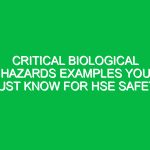Introduction
In industries where explosive atmospheres can occur, ensuring health, safety, and environmental (HSE) compliance is of paramount importance. One of the critical components in achieving this compliance is the ATEX certification. Derived from the French term “ATmosphères EXplosibles,” ATEX certification establishes essential safety standards for equipment and protective systems intended for use in potentially explosive atmospheres. This article delves into the secrets of ATEX certification, emphasizing its relevance in the HSE domain, and providing insights that can lead to enhanced safety and operational success.
Understanding ATEX Certification
ATEX certification is not just a regulatory checkbox; it is a comprehensive framework designed to mitigate risks associated with explosive environments. This certification applies to products and equipment used in industries such as oil and gas, mining, pharmaceuticals, and chemical processing, where flammable gases, vapors, or dust may be present.
The ATEX directive is primarily divided into two categories: ATEX 114 (formerly 94/9/EC) for equipment and protective systems intended for use in potentially explosive atmospheres, and ATEX 1999/92/EC, which outlines minimum requirements for improving the safety and health protection of workers potentially at risk from explosive atmospheres. Understanding these directives is crucial for any organization aiming to achieve HSE success.
The Importance of ATEX Certification in HSE
ATEX certification is vital in creating a robust framework for health, safety, and environmental management. It ensures that equipment is designed, manufactured, and tested to withstand the unique challenges posed by explosive environments. Here are a few key reasons why ATEX certification should be a priority for HSE professionals:
- Risk Mitigation: Properly certified equipment significantly reduces the risk of explosions and fires, protecting both personnel and assets.
- Legal Compliance: Adhering to ATEX regulations helps organizations avoid legal repercussions and fines associated with non-compliance.
- Enhanced Reputation: Companies that prioritize safety and compliance enhance their reputation, fostering trust among clients, stakeholders, and employees.
- Operational Efficiency: Utilizing ATEX-certified equipment can lead to increased operational efficiency, as it is designed to perform reliably in hazardous conditions.
Key Aspects of ATEX Certification
1. Classification of Zones
ATEX zones are classified based on the likelihood and duration of the presence of explosive atmospheres. Understanding these classifications is essential for selecting the appropriate equipment:
- Zone 0: An area where an explosive atmosphere is present continuously or for long periods.
- Zone 1: An area where an explosive atmosphere is likely to occur in normal operation.
- Zone 2: An area where an explosive atmosphere is not likely to occur in normal operation but, if it does, will persist for a short time.
Equipment must be designed and certified according to the zone it will operate in, ensuring maximum safety.
2. Equipment Categories
ATEX certification divides equipment into categories based on their intended use and the zones in which they will operate:
- Category 1: Equipment for use in Zone 0, offering the highest level of protection.
- Category 2: Equipment for use in Zone 1, providing a high level of protection.
- Category 3: Equipment for use in Zone 2, suitable for areas with lower risk.
Understanding these categories helps organizations select the right equipment for their specific needs, thus enhancing safety.
3. Compliance Procedures
The route to ATEX certification involves several critical steps:
- Risk Assessment: Conduct a thorough analysis of the environment to identify potential explosive hazards.
- Equipment Selection: Choose equipment that meets the necessary ATEX category and zone requirements.
- Testing and Certification: Engage a notified body to conduct tests and certify the equipment according to ATEX standards.
- Documentation: Maintain detailed records of compliance and certification processes.
Following these procedures not only ensures compliance but also fosters a culture of safety within the organization.
Benefits of ATEX Certification
The benefits of obtaining ATEX certification extend beyond mere compliance. Here’s how it can positively impact your organization:
- Improved Safety Culture: Prioritizing ATEX compliance encourages a culture of safety, leading to fewer accidents and incidents.
- Increased Employee Morale: Employees are likely to feel more secure and valued in an organization that takes their safety seriously.
- Market Advantage: Being ATEX certified can provide a competitive edge in industries where safety is a top concern for clients.
- Cost Savings: Preventing accidents reduces potential costs related to injuries, property damage, and legal fees.
Best Practices for Achieving ATEX Certification
1. Engage Stakeholders Early
Involving all relevant stakeholders from the outset—including management, safety officers, and equipment manufacturers—ensures that everyone understands the importance of ATEX certification and is aligned in their goals. Regular meetings can help keep everyone informed and engaged in the process.
2. Continuous Training and Education
Ensure that all employees are trained on ATEX standards and the specific risks associated with explosive atmospheres. Regular training sessions can reinforce the importance of safety and compliance, keeping everyone aware of best practices and changes in regulations.
3. Regular Audits and Reviews
Conducting periodic audits of your ATEX compliance status helps identify areas for improvement and ensures that your safety measures remain effective. A proactive approach to compliance can prevent issues before they arise.
Potential Hazards and Risks
While ATEX certification significantly reduces risks, it is essential to recognize that hazards can still exist. Common risks include:
- Static Electricity: This can ignite flammable vapors or dust, so proper grounding and bonding techniques must be implemented.
- Equipment Failure: Even ATEX-certified equipment can fail; regular maintenance and testing are crucial.
- Poor Maintenance Practices: Neglecting maintenance can lead to unexpected failures and increase the risk of incidents.
By understanding these risks, organizations can take further steps to mitigate them, enhancing overall safety.
Regulations and Standards
In addition to the ATEX directives, organizations must also be aware of other relevant regulations that govern safety in explosive atmospheres:
- IECEx: The International Electrotechnical Commission System for Certification to Standards Relating to Equipment for Use in Explosive Atmospheres provides a globally recognized framework.
- OSHA Standards: In the United States, the Occupational Safety and Health Administration outlines standards that may overlap with ATEX requirements.
- ISO Standards: Various International Organization for Standardization (ISO) standards provide guidelines for safety and risk management.
Understanding how these regulations interrelate with ATEX certification helps organizations maintain comprehensive compliance.
Conclusion
In a world where safety is non-negotiable, ATEX certification emerges as a crucial component of health, safety, and environmental management. By understanding its significance, following best practices, and recognizing potential risks, organizations can create safer work environments that protect both employees and assets. The journey to achieving ATEX certification may be complex, but the benefits far outweigh the challenges. As industries continue to evolve, prioritizing ATEX compliance will remain integral to fostering a culture of safety and ensuring long-term operational success.


